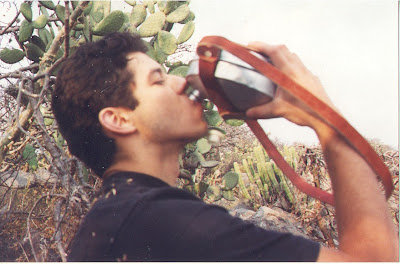Laying down on the operation table, I could see the colorful fishes painted on the ceiling, swimming gaily. Why fishes? Are they the most relaxing thing you can see before surgery? What about threes, or the moon and the starts? I blinked.
When I opened my eyes, I was already in the recovery room. Crap! I was hoping to experience a gradual transition from conscious to unconscious and back, maybe some light at the end of the tunnel. But no, I just blinked and two hours went by, I was in a different room… ah! And there was this pain on my throat and nose.
This was hopefully the last battle on my long war against laryngitis and all throat related diseases. They have been like land mines on my path that too often have ruined my plans. I had already tried everything you can think of: homeopathy, allergy shots, hypnosis, and an amount of drugs that could keep a hip-hop group happy for a year.
So this septoplasty & turbinate reduction was the only thing left, short of voodoo rituals or ceremonial sacrifices in an Aztec pyramid. But there again… have you tried to push needles into a voodoo doll the size and shape of a flu virus? Or for that matter, using an obsidian knife to open my archenemies the dust mite just to find that, like bankers, they don’t have a hearth to offer? So septoplasty it was.
Experiencing hunger and poverty help you understand other people’s actions and motivations. But septoplasty is an experience that had rendered me utterly incapable of understanding why on earth would anyone go through this just for cosmetic reasons! I can’t breathe (like in Mexico city); I can’t talk (like in a nightclub), and I feel just half alive (like when you work and live in Mississauga).
In my particular case most of the pain doesn’t come from the nose, funny enough. It comes from the throat, the very muscle I’m doing this for. Seemingly during the operation they ram a plastic tube down your throat so you can breathe. They were not too gentle.
But there again, hours after the surgery I was watching the documentary “Endurance” about Shackleton’s 1916 expedition to Antarctica. Things started bad when their ship got trapped and then crushed by the ice, and they just got worst: Two years trapped in that white desert, uncommunicated, surviving on seals and penguins, drifting on ice planks, then sailing in precarious lifeboats through violent storms, waves 10 meter high pounding on the small boats. Their clothes soaking in frozen water for days on a row, hungry, tired.
And their final adventure, when the group parted ways on an empty, bare rock island: Shackleton and five others went out to look for help, leaving the rest behind. With barely any food or water, they sailed once more through violent storms for days. Miraculously, they reached the wale hunting island they were looking for, But to get to the wale post they still needed to cross the island, through frozen, bare, rocky mountains. No food, tired, drenched, they started the climb. They could not stop one minute, or they would die right there. Finally, after climbing all night, they found themselves at the peak of a mountain, with a cliff ahead of them. Too late to go back, impossible to move forward. Yet, they knew that if they give up and die, no one would ever know about their friends waiting to be rescued somewhere on a bare rock in the Antarctic. They had no choice but to go on. They peaked into the darkness and jumped, totally blind to what it may lie down below.
At dawn, in the wale hunting post, there was some loud knock at the door. Three semi-human figures stood there, their clothes were just rags from tumbling and sliding down all the way down the mountain. They were asking for a ship to rescue their chums.
I reached out for the remote and paused the documentary, rearranged 3 or 4 of my pillows and pulled the blanket closer to my chin, then I sipped my cup of broth. Yes, quite admirable for Shackleton and company. Still, my throat is in pain. So where is that Tylenol 3, again?

1 comentario:
ya tienes una decada con tu blog
que fuerte....
Publicar un comentario